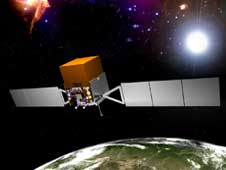The naming of names for astronomical satellites is a funny game. Most are weird acronyms (WFPC, STIS, NICMOS are all Hubble cameras), which many times are puns on the mission itself (FAST). Some are named simply, after astronomers who contributed to the field of study (Chandra, Spitzer). The Swift satellite is not an acronym or named after anyone. It’s just a swift satellite.
 Right now, the Gamma-ray Large Area Space Telescope is very close to launch. But “GLAST” is not the best name. I worked on the education and public outreach for the mission for years, and sometimes the hardest part was using that name (though it made for some fun puns; I wrote articles like “The GLAST Resort”). Because of the picture we used a lot for GLAST, shown on the left, I called it the “flying cheese block”.
Right now, the Gamma-ray Large Area Space Telescope is very close to launch. But “GLAST” is not the best name. I worked on the education and public outreach for the mission for years, and sometimes the hardest part was using that name (though it made for some fun puns; I wrote articles like “The GLAST Resort”). Because of the picture we used a lot for GLAST, shown on the left, I called it the “flying cheese block”.
It’s time to rename GLAST into something cool. And NASA wants you to help.
Got an idea for a new name for GLAST? Send it to NASA (through Sonoma State University)! There are some things you need to know, though. For example, it’s a gamma-ray observatory, so if you want to name it after some gamma ray pioneer, they can’t still be alive (that’s a NASA tradition). The name should be catchy, but not too silly (it’s a $350 million mission that’s managed by both NASA and the Department of Energy, so some modicum of decorum is necessary). It needs to be simple, and easy to say (so Mxyzpltlk is out, even if you try to say it backwards).
I actually don’t have too many ideas. Jan van Paradijs was a beloved astronomer who worked on gamma-ray astrophysics, but his name is too hard to spell for most Americans. Maybe some variation on it?
Please, no Mr. Spaceypants. It doesn’t matter anyway; this isn’t a vote or a contest, just a way to suggest cool names for the mission.
To get you started: GLAST will look at high-energy radiation from black holes, active galaxies, gamma-ray bursts, antimatter annihilation, and even from solar flares. If you go the acronym route, GR is not a bad combo for some good words (can we get GROK out of it? OGRE?). Gamma rays are Super High Energy, too. Also, it’s not a traditional telescope, either.
The deadline is March 31, 2008. So get thinking! Post your suggestions in the comments. Let’s see what we can come up with!